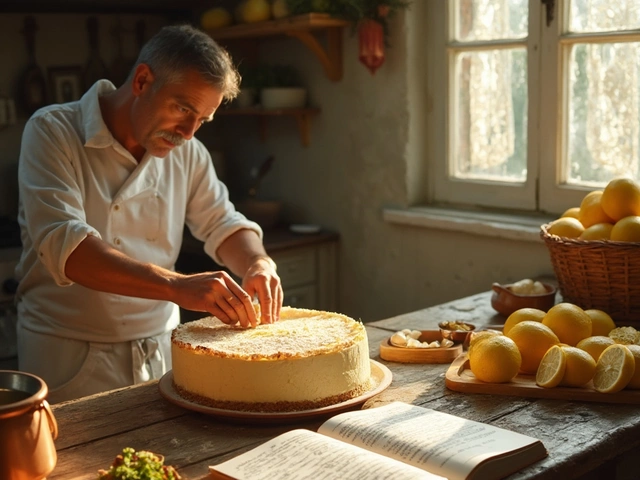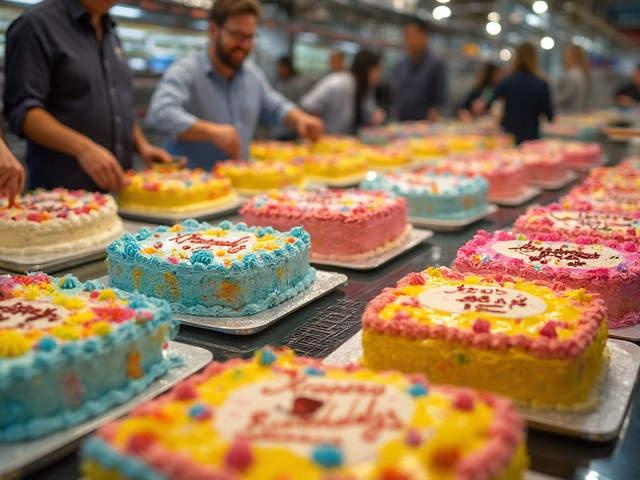When one imagines Brazil, vibrant images of Carnival, football, and breathtaking landscapes might immediately spring to mind. Yet, nestled within its rich cultural tapestry is a world of desserts that spark joy among locals and visitors alike.
The Brigadeiro, a beloved classic, is undeniably the heartthrob of Brazil's dessert repertoire. But how does this beloved chocolate treat compare to a dessert with an Italian flair like Tiramisu? While best known for their decadent experience, these desserts reveal a tale of culinary exchange.
This exploration will not only introduce you to Brazil's most sought-after sweets but also show how diverse flavors from around the world find their place within Brazilian traditions. Prepare for a sweet journey that feeds both heart and soul.
- Introduction to Brazil's Dessert Scene
- Brigadeiro: Brazil’s Chocolate Delight
- Tiramisu: A Global Classic
- A Sweet Comparison: Brigadeiro vs Tiramisu
- Embracing Dessert Diversity in Brazil
- Tips for Enjoying Brazilian Sweets
Introduction to Brazil's Dessert Scene
Brazil, a country known for its cultural kaleidoscope and rich culinary heritage, offers a dessert scene as diverse and captivating as its landscapes. From dense rainforests to sun-kissed beaches, each region boasts a unique array of sweet offerings that mirror the mosaic of cultural influences shaping the nation. Whether it's the African-inspired treats of the northeast or the European confections prevailing in the south, Brazil's sweets offer an adventure into the history and identity of its people.
At the heart of this dessert tapestry is the iconic Brigadeiro, a celebration of simplicity and flavor. This rich chocolate truffle, often rolled in sprinkles, captures the spirit of Brazilian indulgence in small, delightful bites. Brace yourself for the carnival of flavors, where coconut, condensed milk, and tropical fruits like passionfruit and acai frequently steal the show. The sensational allure of these ingredients is testament to Brazil's fertile lands and endless innovation in dessert-making.
There is a fascinating way Brazilian confectioneries unite seemingly unrelated elements into a seamless experience. A vivid example is the influence of international sweets like Tiramisu, which lend their charm to local adaptations, showcasing incredible creativity. This interplay of global and local creates unexpected but irresistible combinations, making it clear why Brazilian desserts have captured the imaginations of epicures worldwide.
Historical and socio-cultural ties play a significant role in defining the dessert culture in Brazil. European settlers brought with them not only ingredients but also techniques that transformed the native way of creating sweets. You can observe these influences most prominently in the state of Minas Gerais, famous for its cheeses, which become a delightful pairing with sweet treats. In the words of renowned Brazilian chef, Alex Atala,
"Brazilian cuisine does not adhere to the rigidity of a single cuisine; it's a beautiful exchange and a fusion of cultures."
Interestingly, traditional Brazilian desserts have started gaining recognition on global platforms, drawing curious gourmands from different continents to explore their unique offerings. It's common to find Brazilian desserts now on the menus in cosmopolitan cities, blending time-honored recipes with modern twists. Coupled with a global spotlight on sustainable and organic ingredients, Brazil's sweets are poised for increased popularity.
The country's vibrant dessert scene is like a treasure trove for confectionery enthusiasts. If you ever stroll through a Brazilian market, you'll be mesmerized by the vibrant hues of fruits lining the aisles and tantalized by the sweet scent from stalls offering freshly prepared desserts. Each bite taken is not only a taste of sugar but a taste of Brazil's soul, history, and innovation.
Brigadeiro: Brazil’s Chocolate Delight
The Brigadeiro holds a legendary status in Brazilian culture, often seen as more than just a dessert, it's a beloved tradition. This little chocolate treat is made with just a few simple ingredients: condensed milk, cocoa powder, butter, and chocolate sprinkles. Introduced around 1945, its origin is tied to a political campaign, named after the Brazilian Air Force brigadier, Eduardo Gomes. The simplicity of its ingredients only adds to its universal appeal, making it both easy to prepare and irresistibly delicious.
For many Brazilians, no festive celebration is complete without Brigadeiro. Its presence is mandatory in children's birthday parties, celebrations, and even as a comfort treat on a quiet Sunday afternoon. The art of crafting these confectionaries, rolling the smooth mixture into little balls and then coating them in chocolate sprinkles, is often a collective family activity, sparking joy and nostalgia. The flavors, while seemingly simple, offer a rich and creamy indulgence that takes time to savor. A Brazilian grandmother might whisper tales of trying to get the perfect consistency, under the bewitching aromas coming from her kitchen.
It's not just about the taste. The experience of making these treats is steeped in a personal and cultural narrative. In the kitchen, families gather, sharing laughter, and passing down recipes through generations. With Brazilian cuisine's global popularity, variations of Brigadeiro have emerged. Some add a sprinkle of sea salt, infuse coffee flavors, or even introduce exotic nuts, showing how tradition can beautifully blend with innovation. "Brigadeiro is like an edible hug," famed Brazilian chef Bela Gil once said, capturing the emotional core of this dessert.
Bela Gil: "Brigadeiro is like an edible hug."
Let us consider statistics to appreciate its popularity further. According to a 2020 culinary survey in Brazil, ninety-three percent of households reported making Brigadeiro at least once a year, showing its strong place in domestic life. This candy is not just a treat but a symbol of hospitality and a deep-seated cultural emblem.
For those eager to make their own Brigadeiro, here's a simple recipe:
- 1 can of condensed milk
- 2 tablespoons of cocoa powder
- 1 tablespoon of butter
- Chocolate sprinkles for rolling
Instructions: Combine condensed milk, cocoa powder, and butter in a saucepan over medium heat, stirring constantly until the mixture thickens enough to show the pan’s bottom during stirring. Let it cool, then shape into small balls, and roll them generously in chocolate sprinkles. Voilà, a delightful taste of Brazilian desserts in your hands!
Whether enjoyed at a bustling party or a calm evening at home, the Brigadeiro offers a sweet escape into Brazilian culture. A single bite speaks volumes about the joys of simplicity, creativity, and the unparalleled warmth of Brazilian hospitality.
Tiramisu: A Global Classic
Tiramisu is a dessert that speaks the universal language of indulgence. Originating from the Veneto region of Italy, it has become a symbol of sophisticated yet comforting sweets worldwide. What makes Tiramisu a standout is its exquisite layering of flavors; each layer tells a story of culinary harmony. It all starts with coffee-soaked ladyfingers, nestling under a rich layer of velvety mascarpone cream. The gentle dusting of cocoa on top draws the senses into a realm of both sweetness and a hint of bitterness. Such simplicity of ingredients — eggs, sugar, coffee, cocoa, mascarpone, and ladyfingers — combined in an artful balance, is what has earned this dessert its global fame. Many believe its name, which translates to "pick me up" or "cheer me up," perfectly encapsulates the essence of enjoying every bite.
"Tiramisu is the ambassador of the Italian art of dessert making. It reflects our way of finding joy and elegance in the simplest of ingredients," said renowned Italian chef, Massimo Bottura.
This classic has seen numerous adaptations as cultures around the world embrace and modify it according to local tastes. You might find Tiramisu with a hint of rum in the Caribbean or spiced with cardamom in the Middle East. Each regional twist adds another layer of cultural richness to the dessert's tapestry. And yet, despite these variations, the core essence of Tiramisu remains intact. It's a cradled moment of indulgence in many people's culinary experiences, often reserved for special gatherings or celebrations. This is what sets it apart from many other desserts — its context is shared moments, connected over the delight of rich flavors.
What draws enthusiasts to Tiramisu isn't just the taste but also the craftsmanship involved. Assembling this dessert requires an understanding of the delicate nature of each component, blending them without overpowering one another. The balance of flavors is, after all, what makes it revered. For home chefs eager to replicate this icon in their kitchens, a simple list could include:
- Layering ladyfingers dipped in strong espresso or coffee.
- Spreading a generous layer of mascarpone whipped with sugar and eggs.
- Finishing with a dusting of unsweetened cocoa powder.
These steps are simple, yet the attention to detail in each can elevate the dessert from merely good to unforgettable. Many Tiramisu lovers assert that allowing the dessert to rest overnight amplifies its flavors, letting the coffee and mascarpone truly permeate. Therefore, patience is a virtue here too. By keeping these keys in mind, Tiramisu not only becomes an exploration of taste but an experience of pausative time, a nod to savoring life's slow, sweet moments.
A Sweet Comparison: Brigadeiro vs Tiramisu
When it comes to comparing Brazilian desserts, the Brigadeiro stands out as an icon of simplicity and indulgence. This chocolate confection, about the size of a small bite, consists mainly of sweetened condensed milk, cocoa powder, butter, and sprinkles. It's a staple at Brazilian celebrations, possessing a rich, chewy texture that melts in your mouth. The Brigadeiro's beauty lies in its straightforwardness, requiring no baking and very minimal preparation. In contrast, Tiramisu, a beloved global classic, showcases a different kind of indulgence rooted in layered elegance. Originating from Italy, it features ladyfingers soaked in espresso and liqueur, layered with mascarpone cheese and dusted with cocoa powder. Though more intricate to prepare than the humble Brigadeiro, Tiramisu offers a creamy, airy bite that transports you straight to the romantic streets of Rome.
While each dessert represents a distinct cultural backdrop, a comparison never fails to celebrate their unique qualities. Brigadeiro embodies the warmth of Brazilian hospitality—served at birthday parties, weddings, and family gatherings, where its presence is both expected and treasured. On the other hand, Tiramisu captures a sense of sophistication, often presenting itself as a delightful conclusion to a formal dinner. Yet both delicacies share a common attribute: their ability to evoke comfort and joy in every bite. In recent years, Brigadeiro has even begun to echo a faint cosmopolitan whiff, as creative chefs around the world experiment with fusions like Tiramisu-flavored Brigadeiros, blending cocoa and coffee nuances.
One culinary critic famously remarked, "Whatever Tiramisu does for your heart, Brigadeiro does it with twice the love and half the fuss."
Interestingly, the appeal of these desserts is echoed in their cultural significance. For Brazilians, Brigadeiro—named after a pioneering politician, Brigadeiro Eduardo Gomes—carries a sentiment that goes beyond its taste. Its origins link back to a campaign in the 1940s, democratizing taste across classes and ages. Contrastingly, Tiramisu's backstory mingles with post-war Italian tales, where abundance of coffee and ladyfingers created culinary magic amidst scarcity. It’s fascinating how both cuisines treat dessert making as an art form and a medium to convey history, turning sugar into stories. In this sweet comparison, it isn’t about which dessert reigns supreme, but about savoring their stories and understanding the heritage they carry on a dessert plate.
A delightful dimension to this cross-cultural comparison is the emergence of unique data points, as food aficionados increasingly conduct tastings blending these iconic sweets. Tiramisu dominates global Google searches, boasting over 5 million monthly inquiries—signifying its worldwide allure—while Brigadeiro, though geographically constrained in search volume, holds undisputed sway in its native landscape. Consider this focus-group conducted table shedding light on dessert preferences:
| Dessert | Preference in Brazil (%) | Global Preference (%) |
|---|---|---|
| Brigadeiro | 75 | 35 |
| Tiramisu | 25 | 65 |
This table reflects an interesting juxtaposition, showcasing how local favorites remain globally poignant yet locally irreplaceable. It is a gentle reminder of how culinary experiences transcend borders with flavor as the universal language.
Embracing Dessert Diversity in Brazil
Brazil’s rich melting pot of cultures is mirrored in its vibrant dessert scene, where a delightful array of sweet treats celebrates the country’s diverse heritage. As a nation built on waves of immigration, Brazilian cuisine is an exhilarating mix of indigenous, African, European, and Asian influences. This vast tapestry manifests prominently in the realm of sweets, offering an exhilarating journey for dessert enthusiasts.
With each region hiding its own unique sugary secrets, a journey through Brazil’s desserts takes one from rich, chocolatey Brigadeiros—the quintessential Brazilian dessert whose divine simplicity has captured hearts nationwide—to exotic treats like Açaí na tigela, a refreshing Amazonian fruit bowl dancing with tropical flavors. Such sweets capture the imagination and transport taste buds straight to Brazil’s sun-kissed shores. At times, Brazil’s desserts reflect a harmony of contradictions: creamy quindins blend Portuguese and African culinary heritage, presenting a luscious yolk custard that is as rich in taste as it is in culture.
It is impossible to overlook the layered influence of international cuisine. From the rise of European classics like Tiramisu intermingling with local flavors, to the sumptuous Italian Panettone that has found its home as a timeless Brazilian Christmas treat. According to culinary historian Carlos Alberto Dória, "Brazilian sweets narrate tales of adaption and local creativity, standing as delicious evidence of our cultural exchanges." Blending tangy tropical fruits with traditional recipes has inspired creations that are both familiar and strikingly original, such as passionfruit mousse or coconut flans, which bring a distinctively Brazilian twist to global classics, offering an unforgettable culinary experience.
In modern Brazil, one could witness the emergence of new dessert trends that echo contemporary global tastes, yet are inherently Brazilian in spirit. The rise of vegan and gluten-free options made from indigenous ingredients highlights a notable push towards health-conscious indulgence, indicative of Brazil's ability to innovate without losing culinary authenticity. Markets teem with brigadeiros made from organic cocoa or exotic fruits, catering to the global palate without compromising the authenticity that makes them enchanting.
If one were to embark on a sweet journey across Brazil, they would find that desserts here are about more than just taste. They echo cultural memory, adaptability, tradition, and modern innovation, presenting a bona fide edible narrative full of vitality. Brazil’s desserts are indeed as multi-faceted as its landscapes, making them an integral part of understanding the beauty of Brazilian life. In essence, by embracing dessert diversity, we embrace the kaleidoscope of influences that make up the vibrant tapestry of Brazilian identity.
Tips for Enjoying Brazilian Sweets
Diving into the world of Brazilian sweets is an adventure for the senses, offering not only delightful tastes but also a vibrant cultural experience. To truly savor these treats, one needs a dash of curiosity and a splash of open-mindedness. Begin by exploring Brazil's unique flavors at local pâtisseries or street markets, where the freshest Brigadeiros are often found. These bite-sized chocolate truffles, made from sweetened condensed milk, butter, and cocoa, are the embodiment of Brazil's sweet tooth. But if you really wish to engage with these flavors, try making Brigadeiros at home. Not only is this a fun activity, but it also brings a taste of Brazil to your kitchen.
Finding the best dessert experience also means understanding the local culture surrounding it. In Brazil, sweets are more than just a dish; they are part of a gathering, a joyous celebration of taste and togetherness. It's common to find sweets being served at birthday parties, weddings, and festive events, emphasizing community and conviviality. Try pairing a classic Brigadeiro with a cup of strong Brazilian coffee for a taste sensation. Remember to check local etiquette—sometimes savoring a sweet is as much about when and how it's eaten as it is about the dessert itself.
Another tip is to appreciate the fusion of global flavors within Brazilian delights. Tiramisu, although Italian in origin, can be found merging effortlessly in Brazilian dessert trays. This versatility showcases Brazil's embracement of global culinary innovations. For those eager to taste these cultural blends, look for artisanal bakeries that pride themselves on innovation—or try your hand at creating a Brazilian twist on Tiramisu. Use local ingredients like açaí for a unique flair that reflects the country's bountiful produce.
Lastly, when indulging in these sweet delights, it is essential to embrace the shared joy of exploration and discovery. Invite friends or family to participate in tasting sessions; sharing adds a new dimension to the experience, allowing stories and cultural exchanges to flourish. As the famous Brazilian chef, Helena Rizzo once said,
Encounters at the table are what make cooking and eating so extraordinary.By being mindful of these tips, you'll not only enjoy the sweets themselves but also the stories, heritage, and joy that accompany them.





